I first become interested in zero energy buildings in 2003. There were several things that pulled me into the concept, and probably the most compelling aspect was the scale of the change. At the time, I was managing a municipal green building program and we were struggling to convince developers to make relatively minor incremental changes like using low-e windows or high efficiency furnaces. The notion of zero energy was such a radical leap forward. The other big thing that was intriguing to me, let’s face it, was that it was cool.
Zero energy as an aspiration, on-the-ground reality, and climate solution movement is at an interesting point in its history. Zero energy is all the rage, with many more organizations and events actively addressing it as a topic. Many utilities are starting to look into a likely future of much higher efficiency buildings with integrated photovoltaics, and are trying to figure out the ramifications of shrinking base loads and peaking generation when the sun is out. Even though at this point we only have 43 certified projects, things are clearly taking the next scale step up—we are nearing 400 registered projects. From our unique position of engaging with many high-profile players and projects in feasibility, we are able to see zero energy taking the next big step.
As zero energy becomes more mainstream, it is a great time to step back and think about what role zero energy has taken to date, which informs its value proposition moving forward. Here are seven observations I’ve learned since zero energy buildings first piqued my interest nearly 15 years ago.

Zero Energy is a Key Element of an Integrated Philosophy of Design
When zero energy was integrated into the Living Building Challenge in 2007, another design perspective was introduced. Buildings are like flowers, receiving all the energy they need from the sun, sharing energy in a reciprocal relationship with their biotic community, and operating at the far reaches of efficiency. Zero energy was not just cool, it reflected a higher, deeper system of design thinking fundamentally based on nature and biomimetics.

Zero Energy Brings People Together
In today’s complex times, perhaps the most compelling aspect of zero energy is represented by what I witnessed during the zHome open houses in 2012. I had directed development of this groundbreaking project, the first multifamily zero energy project in the United States. The team did a thorough job planning and marketing tours of the project, held over nine weekends. We ended up having 10,000 people visit the project for two, deep dive tours of the project. It wasn’t the numbers, though, that I found most compelling. It was the diversity of backgrounds. Yes, we had many NPR-listening, Seattle-dwelling urbanites make the trek out to the suburbs, but we also had just as many average folks. Perhaps the most gratifying crowd was the large numbers of visitors from east of the Cascades, the “red” part of the state. Zero energy brings together many threads: climate solutions, practicality, gee-whiz, can-do, high-tech, that transcend the typical narrative of today.
Zero Energy Drives Efficiency
So what else is zero energy good for? A lot more, actually.
Zero energy buildings provide a couple key self-limiting mechanisms to drive efficiency. These elements force buildings to reduce their Energy Use Intensity (EUI) to match the available renewable generation on site. Similarly, zero energy buildings have a self-reinforcing financial mechanism for efficient systems. A more efficient building results in the need for fewer renewables, which have substantial cost. While it is true that in the past, higher solar costs really reinforced this financial container—essentially almost anything you could dream up on the efficiency side would be less expensive per watt saved than renewable generation. But even at lower renewable prices, it still reinforces scouring the alternatives for efficiency gains.

Zero Energy Connects the Building and Occupant
Another powerful aspect of zero energy is that it tunes users into the energy performance of the buildings in which they live and work. In zero energy buildings, systems are so efficient that typically, the single largest loads are from the users. Zero energy performance rests in the hands of the occupant, which is perhaps more effective than any other strategy to reduce their usage. Related to this is zero energy’s reinforcement of self-identification with next-generation energy systems. Hosting a small power plant on your roof connects users with energy in a way that a power line does not.
Zero Energy Makes the Grid More Efficient
Zero energy buildings (ZEB) also place energy production at the point of use, meaning there is no line loss (at least when the ZEB is using the onsite production, but typically ZEB projects are in urban settings, where excess generation is used just offsite). The average line loss within the United States, for example, is 5%. That is a lot!

Zero Energy is Space Efficient
Roof-mounted offsetting solar also has lower impact on the environment that many larger utility scale renewables, which may form their own monoculture, especially when the installation sites are graded, graveled, and fenced. Roof space is an often underutilized asset, and zero energy buildings turn that into valuable space.
Zero Energy Supports Local Economies and Stable Investment
Purchasing of building mounted renewable energy also supports the local economy. The majority of solar industry jobs are in installation, meaning zero energy buildings provide additional skilled labor jobs. Finally, for many people, real estate assets form the core, conservative component of their investment portfolio. Improving the quality of those assets by making them lower cost in operation, higher quality, and more durable, all reinforce their investment profile and benefit.

Recently, the International Living Future Institute released a new limited exception allowing renewables to be placed off-site, for tenant improvements, areas with grid constraints, and high-energy intensity/high density uses. In crafting the conditions under which this exception could be used, we drew from many of these beneficial elements of zero energy, seeking to rebuild it conceptually in albeit a deconstructed fashion.
In this era of climate obfuscation, tangible, positive climate solutions are critical. While zero energy buildings and communities don’t get us all the way to the energy end game (I’ll save that discussion for later), they are a really big part of it. We’re grateful to be one of the key zero energy leaders worldwide, and look forward to resolving the fossil fuel conundrum together.



